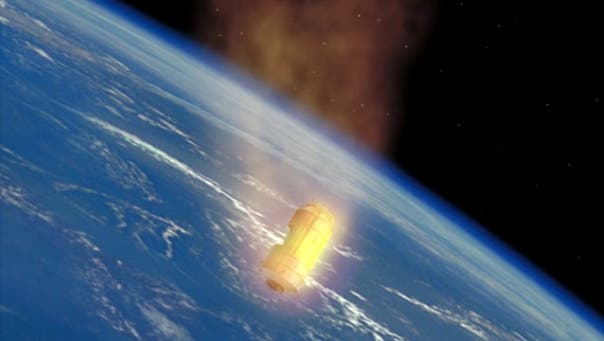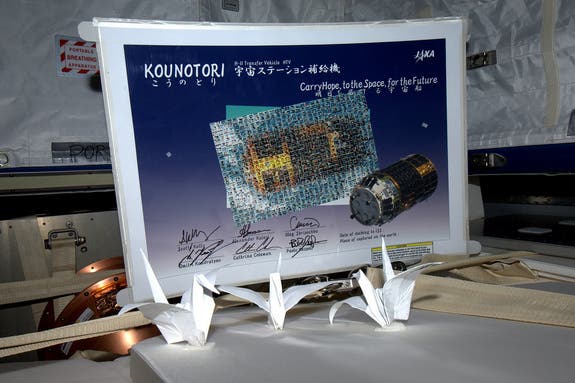
Artist impression of Japan's robotic cargo ship, the H-2 Transfer Vehicle, entering Earth's atmosphere. (c) JAXA
Yesterday, Japan’s unmanned space freighter Kounotori 2, of the H-2 Transfer Vehicle class, intentionally entered Earth’s atmosphere where it crashed and burned after its two months mission supplying the International Spate Station – with it a slew of junk off the space station was dumped.
Attached to the H-2 Transfer Vehicle was also a sensor which measured and transmitted various data back to scientists of the plunging inferno headed straight into the Pacific Ocean. The device is called Re-entry Breakup Recorder, or REBR for short – recorded temperature, acceleration, rotational rate and other data during the spacecraft’s high dive into Earth’s atmosphere. The REBR device didn’t need to be recovered, but data analysis could take 6 to 8 weeks to get successfully processed.
“REBR collected data during the breakup of the Kounotori 2 vehicle and successfully ‘phoned home’ that data prior to final impact,” said William Ailor, Director of the Center for Orbital and Reentry Debris Studies at The Aerospace Corporation in El Segundo, Calif. “In fact, it is still transmitting while floating in the ocean.”

Three paper origami cranes were packed aboard the Japanese cargo ship Kounotouri 2 before being released to burn up in the Earth's atmosphere. More origami cranes were distributed both in the Houston and Tokyo mission control centers. (c) ESA/NASA/space.com
In a touching gesture, while the Kounotori 2 was still docked, ISS astronauts tried to share their sympathy for the Japanese people, who are still suffering greatly from the March 11 double catastrophe, by putting three paper cranes in the cargo spaceship they hand made.
“These are our extraterrestrial cranes, a symbol of hope, put into HTV for all Japanese people,” the astronauts wrote in a message accompanying the photos. “We are with you!”
The Kounotori 2 was a freighter operated by JAXA, the Japanese space agency, which is a major player in the $100 billion International Space Station project. Japan built the orbiting structure’s largest laboratory, called Kibo (“Hope”).
The spacecraft was about 33 feet (10 meters) long and 14 feet (4.4 m) wide, and carried cargo inside a pressurized compartment – which astronauts could retrieve after docking – as well as haul spare station parts on an unpressurized pallet to be retrieved by a robotic arm.
“The HTV-2 carried various important cargo, including spare units of the external ISS system and potable water for the crew, which has been mostly transported by the space shuttle up to now,” JAXA President Keiji Tachikawa said in a statement. “I believe that this success proves that the HTVs are reliable transportation vehicles essential for maintaining the ISS, and that Japan, as an international partner of the ISS, is eligible to play an important role for ISS operations.”
This is the second HTV cargo spaceship JAXA has launched, after the equally successful run of the HTV-1 launched in 2009. JAXA’s third cargo launch, the HTV-3, is scheduled for 2012.









